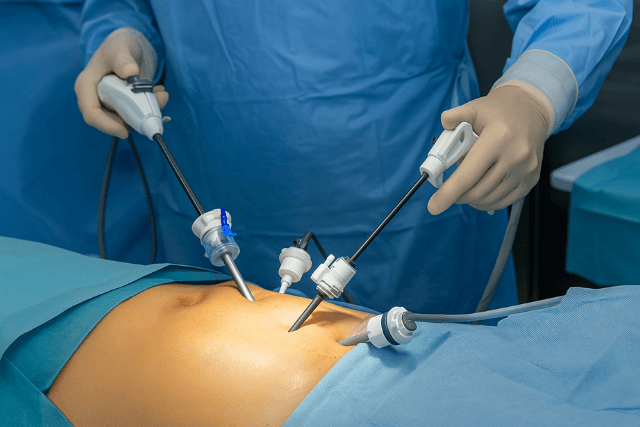Gall bladder removal surgery, also known as cholecystectomy, is one of the most common surgical procedures performed worldwide. Doctors often recommend it when gallstones cause pain, inflammation, or digestive problems. Many people live perfectly healthy lives without a gall bladder, making the surgery both safe and effective.
Understanding gall bladder removal surgery fully helps patients prepare, manage their recovery, and reduce anxiety. This blog explores every aspect of the surgery, including preparation, procedure, recovery, and lifestyle adjustments.
Why You May Need Gall Bladder Removal
The gall bladder stores and releases bile, a fluid that helps digest fats. However, for many people, this small organ becomes more of a problem than a benefit.
Gallstones and Inflammation
One of the leading reasons for gall bladder removal surgery is the presence of gallstones. These hard deposits form when bile contains too much cholesterol or waste. They can block bile ducts, leading to sudden and sharp pain in the upper right abdomen. In some cases, inflammation called cholecystitis develops, causing fever and nausea.
Biliary Dyskinesia
In some patients, the gall bladder does not empty properly. This condition, known as biliary dyskinesia, results in chronic discomfort and poor digestion. Doctors may suggest surgery if other treatments do not improve symptoms.
Gall Bladder Polyps
While most polyps are benign, some can grow large or increase cancer risk. If polyps reach a certain size, removal may be recommended.
Gall Bladder Cancer
Though rare, gall bladder cancer sometimes requires surgical removal of the organ along with nearby tissue. In these cases, early detection is essential for effective treatment.
Symptoms That May Lead to Surgery
Knowing the symptoms that might result in gall bladder removal surgery helps patients seek timely care. Common signs include:
- Sudden pain in the upper right or center of the abdomen
- Pain that worsens after eating fatty foods
- Nausea or vomiting
- Fever and chills
- Jaundice, or yellowing of the skin and eyes
These symptoms may indicate gallstones or other gall bladder issues. Therefore, medical evaluation is essential when any of these symptoms appear.
Diagnosis Before Surgery
Before proceeding with gall bladder removal surgery, doctors use several tests to confirm the diagnosis.
Ultrasound
This imaging test is the most common tool used to detect gallstones. It provides clear images of the gall bladder and surrounding structures.
CT Scan
In certain situations, a CT scan helps doctors rule out other conditions or identify inflammation and infection.
HIDA Scan
This nuclear medicine test tracks the flow of bile and evaluates how well the gall bladder is functioning.
Blood Tests
Doctors often order blood tests to check for signs of infection, liver function, or blocked bile ducts.
Together, these tests provide a full picture of what’s causing the symptoms and whether gall bladder removal surgery is the right solution.
Types of Gall Bladder Surgery
There are two primary methods for gall bladder removal surgery. Both are effective, but they differ in approach and recovery time.
Laparoscopic Gall Bladder Surgery
This is the most common technique. Surgeons make a few small incisions in the abdomen and insert a tiny camera and surgical tools. This minimally invasive procedure usually takes one to two hours and allows for a quicker recovery.
Open Gall Bladder Surgery
In some cases, doctors recommend an open surgery. This involves a larger incision and is used when the patient has complications, scar tissue, or other factors that prevent laparoscopy.
Although recovery takes longer, the open method is just as successful in removing the gall bladder and relieving symptoms.
What to Expect Before Surgery
Preparation is a key part of gall bladder removal surgery. Your healthcare provider will give specific instructions based on your condition and the surgery type.
Pre-Surgery Consultation
Doctors will review your medical history, conduct a physical exam, and go over any medications you’re taking. You may be asked to stop certain medications, especially blood thinners, before surgery.
Fasting
Patients are usually instructed not to eat or drink for at least eight hours before the procedure. This helps prevent complications during anesthesia.
Arrangements
Since you won’t be able to drive afterward, you should arrange for someone to take you home. If you’re having outpatient laparoscopic surgery, you can usually return home the same day.
What Happens During Surgery
Understanding the actual process helps reduce anxiety. Here’s what typically occurs during gall bladder removal surgery.
Anesthesia
First, a healthcare team member will administer general anesthesia, so you will be asleep during the entire procedure.
Incisions and Removal
For laparoscopic surgery, small incisions are made, and the surgeon removes the gall bladder using a camera-guided instrument. For open surgery, a larger cut is made below the ribs to access the organ directly.
Completion and Recovery Room
Once the gall bladder is removed, the incisions are closed with sutures or surgical tape. You will then be moved to a recovery room where nurses monitor your vital signs and pain level.
Immediate Post-Surgery Care
After surgery, the focus shifts to managing discomfort and ensuring a smooth recovery.
Monitoring
Nurses and doctors will monitor your breathing, heart rate, and surgical sites. You may receive pain relief medication and fluids through an IV.
Movement
As soon as it’s safe, you will be encouraged to get out of bed and walk. This helps prevent blood clots and promotes faster healing.
Discharge
Many patients go home the same day after laparoscopic surgery. However, open surgery may require a hospital stay of two to three days.
Gall Bladder Removal Recovery Timeline
Knowing what recovery looks like makes it easier to plan. The recovery after gall bladder removal surgery depends on the type of surgery performed.
Recovery After Laparoscopic Surgery
- Most people return to normal activities within one week
- Driving is usually safe within three to five days
- Full recovery takes about two to three weeks
Recovery After Open Surgery
- Hospital stay may last several days
- Activity should be limited for at least four to six weeks
- Full recovery may take up to eight weeks
Managing Pain and Discomfort
Pain is a natural part of the healing process. However, you can take several steps to manage it.
- Take pain medications as prescribed
- Use a heating pad to soothe sore muscles
- Avoid lifting heavy objects
- Rest when needed, but keep moving gently
Always communicate with your doctor if pain becomes intense or persistent.
Diet After Gall Bladder Removal
Your body still produces bile after gall bladder removal, but it flows directly into the small intestine. Because of this, you may need to make some dietary adjustments.
Eat Smaller Meals
Eating smaller, more frequent meals helps the digestive system work smoothly.
Choose Low-Fat Foods
For best results, stick to lean proteins, steamed vegetables, and whole grains. In contrast, avoid fried, greasy, or high-fat meals that may cause bloating or diarrhea.
Introduce Fiber Slowly
While fiber is important, adding too much too quickly can upset your stomach. Gradually increase your intake of oats, fruits, and legumes.
Long-Term Health After Surgery
Most people recover fully and enjoy a better quality of life after gall bladder removal surgery. Here’s what you can expect over the long term:
- Digestive problems usually improve
- Gallstone-related pain disappears
- Energy levels return to normal
- You can resume exercise and regular activities
Although some people experience loose stools or bloating, these symptoms often go away with time and dietary adjustments.
When to Call Your Doctor
While complications are rare, it’s important to know when to seek medical help after gall bladder removal surgery.
- Severe or worsening abdominal pain
- High fever or chills
- Redness or drainage from the incision
- Persistent vomiting or nausea
Prompt attention to these signs can prevent more serious issues and support faster healing.
Tips for a Smooth Recovery
For a successful outcome after gall bladder removal surgery, follow these expert tips:
- Follow your doctor’s instructions closely
- Keep your follow-up appointments
- Get plenty of rest during the first week
- Avoid heavy lifting for several weeks
- Stay hydrated and eat balanced meals
With proper care, you’ll likely feel stronger and healthier in just a few weeks.
Final Thoughts
Gall bladder removal surgery is a safe and effective solution for conditions like gallstones, inflammation, and other gall bladder issues. Understanding what to expect, how to prepare, and what recovery involves can reduce fear and improve your overall experience.
By following medical advice, maintaining a healthy diet, and giving your body the time it needs to heal, you can return to your daily life with fewer symptoms and better health. If you have symptoms or have been advised to consider surgery, talk to your doctor about whether gall bladder removal surgery is right for you.










